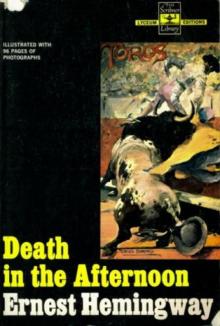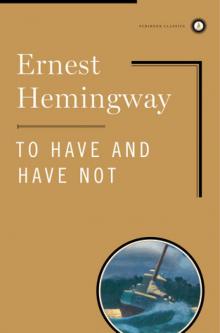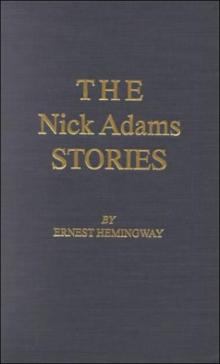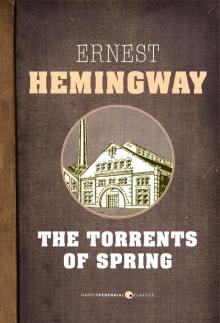- Home
- Ernest Hemingway
Dateline- Toronto Page 6
Dateline- Toronto Read online
Page 6
Going from even such a car as the Complex Collapsible to a Pierced-Sparrow is only comparable to the initial jump out of the Fordowner class. A Pierced-Sparrow is the insignia of success. In our modern system of civilization the Pierced-Sparrow takes the place of the heads that our ancestors used to dry in the smoke of their hut fires. In the Pierced-Sparrow are concentrated all the scalps of his business competitors. It is better than the accolade. He thinks that if he has a Pierced-Sparrow it will mean that he has arrived in the elect.
So he buys a Pierced-Sparrow, unhappy man! As soon as he has the Pierced-Sparrow he discovers that a great many other people have them too. Then one day at the club he overhears this conversation:
“What kind of a car has he?” asks the first gentleman.
“Pierced-Sparrow,” replies the second, blowing a cloud of smoke.
“Upper Middle Class people, eh?” says the first comfortably.
It is the beginning of the end. The ex-Fordowner has achieved business success. He has raised a son who knows more than his father. He has a daughter who smokes cigarettes and has been a successful debutante for eight years. He has enough servants to make him uncomfortable. You would imagine that he would be happy. But he is not.
He makes one last desperate effort to escape from the Other Half. He buys a Rice-Rolls. He can’t afford it, of course. But it is necessary for his self-respect. The Rice-Rolls is the ultimate.
Now if this were comedy we would leave him in happiness riding through life in his Rice-Rolls, having attained the true happiness of success. His chauffeur might even let him drive his Rice-Rolls sometimes. Nothing would be lacking. His son would know more every day and his daughter would learn to roll her own. But this is tragedy.
There is no peace for him this side of the sepulcher. We have reliable information from England that a super-car is being brought out which will cost at least four times as much as the Rice-Rolls. The curtain falls upon the tragedy of How the Other Half Lives.
Prizefight Women
The Toronto Star Weekly
May 15, 1920
Toronto women were present at prizefights for the first time last Saturday night. A press agent story said there would be four hundred boxes filled with members of society attending the bouts in evening clothes. There really were about a hundred women present.
They came ostensibly to see Georges Carpentier give a sparring exhibition. In reality they saw a series of gladiatorial combats and they smiled and applauded through it all. For the benefit of those Toronto women who do not attend prizefights, this is what they saw, and this is how they acted.
In the center of the floor of the Arena is a raised platform with a square of roped-off space. Rows of seats are banked on each side of the ring. A number of women were sprinkled among the men who occupied these ringside places. More women were scattered in the boxes along the side of the ring.
Two women sat just behind me at the ringside with their escorts.
“They wear gloves so they can’t hurt each other,” one of the men explained to his girl.
In the first bout a young stockily built Jewish boy in about a minute and a half clouted into insensibility a much smaller, weaker and inexperienced lad from Hamilton. The little kid never had a chance against his huskier opponent, who smashed him around the roped enclosure from the clang of the gong, and finally hit him hard enough so that he stayed on the floor. It was not a display of skill, of science nor of nerve. It was simply a case of a larger, stronger kid knocking a smaller and weaker kid unconscious. It was not a pretty sight.
“My, that one was over quickly!” said one of the women back of me, with obvious disappointment.
“I’ll say it was,” exulted her partner. “Young Lisner sure clouted that baby plenty.”
The second so-called boxing bout was even shorter. A hardfaced, heavily muscled slugger with a reputation for cowardice was in one corner. A big, fat, lubberly chap, who looked as though he had never been in a ring before, occupied the other.
As the gong rang the craggy-faced slugger shot out of his corner. The dub made an awkward attempt to put up his hands. The slugger swung his right fist in a deadly semicircle to the dub’s jaw, and the fight was over. The fat, untrained dub crashed on his face on the resined canvas. When his seconds pulled him over to his corner, the canvas had sand-papered most of the skin off one side of his face. The slugger had knocked out the set-up provided to get him back into the good graces of his home-town as a fighter.
He spat on the floor, assumed a “look what I’ve done to that guy” expression, and walked out of the ring and climbed down the platform.
Everyone applauded, including the ladies.
“He hit him pretty hard, didn’t he?” said one of the women.
“I hope ta tell ya he did,” answered her partner gleefully.
Over in his corner the dub’s handlers were working over him, sponging the blood off his sandpapered face and bringing him back to his senses with cold water. It was not a pretty sight.
It was during the fourth bout between a hard-hitting, perfectly conditioned little Toronto fighting machine named Benny Gouldand a willing, nervous youth from Buffalo who was proving himself a good bleeder that the women’s attention was distracted from the ring. A box party of prominent Torontonians entered and settled themselves in the box. Every woman in the Arena eyed them in a quick attempt to identify the ladies of the party whose coming gave social sanction to their own presence.
Just then the willing bleeder from Buffalo landed his first blows of the fight, and there was a burst of applause. The slender kid with the badly smashed face was fighting back like a tiger and soon had young Gould’s face bloody. But he was outclassed by the more experienced boxer, who continued to batter him till the end of the fight.
The society box party smiled and applauded all through the fight. But the hardened fans at the ringside, while they applauded the game fight the Buffalo kid was making, did not smile. For they could see the terrific punishment he was taking. They watched the way Gould kept smashing his left fist onto the kid’s broken nose. They knew the way Gould’s punches were weakening the kid. They admired his game fight but they did not smile. But the ladies in the box party smiled every minute.
In the old days at the Colosseum in Rome the ex-gladiators and their pals who sat at the side of the arena applauded the deadly thrusts. They clapped when a swing of the cestus bashed in a Cisalpine gladiator’s face. They may have cheered when the man with the fishnet and the trident entangled his opponent with the short sword and they clapped when he finished him with a few well-placed thrusts of the spear. But they didn’t laugh. They knew what it meant.
“He jests at scars who never felt a wound.” And as on last Saturday night the laughter was reserved for the nobility.
Then the champion of Europe and the idol of France, with a name that is pronounced as many ways as Ypres used to be, danced through four rounds with his sparring partner. The sparring partner was evidently selected because of his startling facial likeness to a certain Mr. Jack Dempsey. His name is Lanaers, pronounced Lanears by the referee and he lets M. Carpentier hit him about two hundred and fifty times during the course of the entertainment.
Carpentier showed the ladies present that he has a nice taste in dressing gowns, two hands that strike as fast as cobras, and a rather good-looking face. He got into the ring, stood at attention while the “Marseillaise” was played and then slapped, poked, jabbed, stabbed, jolted, hooked and biffed Lanaers around the ring for four short rounds. Then he left the ring and went home.
But did any of the ladies who had come only to see Georges Carpentier leave after he had made his exit? They did not. They stayed and cheered while chubby Bobby Eber of Hamilton clouted Toronto’s gamest and toughest featherweight around the ring for six rounds. And the two ladies who sat back of me were several times distinctly heard yelling for a knockout.
Is it the magic name Arena that brings back to the alleged gentler sex their old
Roman attributes? Lecky, the historian, says that the majority of the old gladiatorial crowds were women.
Madame Carpentier wasn’t there though. Her husband is a fighter and she knows what it means. So she stayed home and waited for Georges.
Galloping Dominoes
The Toronto Star Weekly
May 22, 1920
Prancing Parchesi has invaded the realm of sport of Toronto’s smart set. Formerly bridge was the only recognized method of coaxing money out of one pocket into another. Now Mississippi Marbles play the role of the great kale transferer. Galloping Dominoes have at last come into their own in the high life. In short, Toronto society is shooting craps.
The game may have been introduced by some member of the well-tailored staff who in the course of his activities as a conducting officer was brought into forced contact with the hoi polloi. He observed the manner of play with the cubes of certain of the rougher elements of the troops he conducted to England. On his return from the rigors of conducting, to show his familiarity with the lower classes, he introduced the game. It was a kind of slumming at first.
However the game was introduced, it is now firmly established. And now being able to seven easily and graciously on the initial roll is as much a social asset as the ability to negotiate a five-barred gate in good form.
Craps is defined in the dictionary as: “U.S. Local. A game of chance in which the object is to guess the numbers thrown on two dice.”
That is what it may have been originally. Now it is international. Starting originally as a Negro game along the Mississippi waterfront, it has spread to every part of the world and is perhaps the most popular game of chance today.
Wherever the Yank has wandered, been sent, or fled to, he has taken the bones with him in the bottom of his tightest pocket. But they haven’t remained there. They have come forth to the light and worked for him and spread their peculiar verbiage over most of two hemispheres.
For the benefit of those who are confronted with a succession of crap stories in the magazines, and whose knowledge of the game is only that it has something to do with seven and eleven, it might be explained. Since such highbrow writers as Joseph Hergesheimer have taken to writing crap stories such as his “Read Them and Weep” in a recent Century Magazine, it behooves the non-gambling reader to know something of the game purely for literary purposes.
The rudiments of Senegambian Polo are these:
The man rolling the dice decides what stake to put out. This is covered, or faded, by his opponent. The man with the dice then rolls.
He loses on the first roll of the two dice if the spots added together make two, three or twelve. This is called crapping out.
He wins on the initial roll if the numbers of the cubes add to seven or eleven.
If the shooter rolls any other number than those mentioned previously, he rolls again until he either wins by again rolling his first number or loses by rolling a seven.
That is all there is to craps on the surface. But the true crapshooter knows that it is a psychological study, a test of judgment, and that a knowledge of the law of averages is necessary to success. This is not a treatise on “how to shoot craps,” but merely a statement of the remarkable way in which a game starting from such a lowly source has spread to such high places. The finer points of crap shooting will not be gone into. However, the dictionary was only half right. Craps is only to a limited extent a game of chance. If you don’t believe this, try your luck against an experienced manipulator of the ivories. It shouldn’t take him longer than about six passes to convince you that craps is a game of skill.
Toronto society can rest assured that it is not the only smart set that is playing Louisiana Lacrosse. While the gay blades kneel about the tea table and adjure Little Joe to come to father that baby may not be unclothed, they can be comfortable in the knowledge that they are quite au fait. For a certain Italian cavalry regiment whose officers rank socially with British Guards officers has been marked with the cloven hoof of the Yank and craps is the regimental passion.
An American consul tells of entering the barracks of the regiment and coming into the high-ceilinged dining hall, the walls lined with cases that contained the trophies of the regiment’s glorious history.
Kneeling on the floor of the dining hall in a reverent attitude were three captains, a major and a lieutenant of the Imperial cavalry and a young American sublieutenant.
The colonel was juggling the bones in his hand and addressing them in words the meaning of which he did not know, but whose potency he had often witnessed.
“Leetle Fever! Come to ze Doctor,” shouted the colonel, giving the cubes a Latin twist. A five appeared.
“You’re faded,” said the American, and he and the captain covered the bills that the colonel left on the floor.
The colonel rattled the dice in his hand and then shot them out onto the tiled floor. A ten showed. “Dieci!” said the captain joyfully.
“Beeg Deeck from Bawston!” The colonel caressed the cubes as he picked them up. He fondled them. He blew on them softly. “Reechard ze Lion ‘Earted rally round. Wham!”
It was a ten and the consul tiptoed out of the room. He was homesick and he couldn’t afford to lose.
Toronto society shouldn’t worry, its dalliance with the joy cubes has plenty of precedent. But I hope for their own sake that in their manipulations of the gallopers they never run afoul of a certain colonel of Italian cavalry.
Photo Portraits
The Toronto Star Weekly
May 29, 1920
You can pay as much or as little as you wish for a photograph in Toronto and you can have it look as much or as little like you as you wish to.
Strange to say, the less accurate reproduction you want, the more it costs. For twenty-five cents on Yonge Street you can obtain a perfect rogue’s gallery likeness while you wait. Every facial attribute will be as plain and distinct as in a life mask. It will be an exact reproduction. But we are not a beautiful race, the unfair sex at least, hence the existence of the artistic photographer.
The announced aim of the artistic photographer is to photograph personality. That is flattering. We observe the wonderful-looking men whose photograph personalities illuminate the windows of the artistic photographers and smile. Perhaps our personality when photographed will look like that.
But you cannot get your personality photographed for twenty-five cents. It costs nearer twenty-five dollars for three good-sized reproductions of a personality. But it is worth it if the photo really shows the true personality.
Showing a personality, as far as we are able to discover, consists in revealing with great clearness the features of people with attractive, good-looking faces and very kindly blurring the rather undesirable countenances of the rest of us. Our own personality is very unkindly concealed behind our face. We have always esteemed it a great privilege to be behind our face rather than in front of it. However, on viewing the wonderful-looking creatures in the window, we thought that perhaps the photographer could do something for us.
So we awaited the proofs with great expectations. There did not seem to be anything very mysterious about the way the photographer took the picture. We sat on a chair and turned when bidden. He arranged some screens for the lights and capped and uncapped the muzzle of the big camera. We were astounded at his consummate artistry. Personalities revealed with that simplicity of technique. It was astounding. We awaited the proofs. As we passed out we stole another glance at the man on the wall with the Eugene O’Brien “Chase me and I won’t run” look in his eyes. Perhaps we might even look like that.
Then the proofs came. It was terrible. We have no personality. It was just the face. Blurred artistically to be sure, but the same old face. The same homely but honest countenance that has stared reproachfully at us out of a thousand shaving mirrors looked at us from the proofs.
“You can’t get away from me,” it seemed to say. “You can blur me all you want to. But I’m the same old face.”
There is an innovation in photographing being introduced into Toronto now that holds out hope even for those with a countenance that defies the blurrers of art. The latest fad is miniatures which are painted from photographs and cost from two hundred to five hundred dollars.
In a miniature there is room for latitude. After the artist has blocked in a representation of the subject’s facial troubles the subject should be allowed to make suggestions. If your nose is not to your liking, tell the artist so and have the type of Greco-Roman proboscis that you admire included in the miniature.
If you have big ears, suggest to the artist that he reduce the ears to half a column. Select your own type of mouth. In this way we will be able to get a picture of ourselves that really pleases us.
That is the trouble with photographs, even the blurry ones, they are too blamed accurate.
Fox Farming
The Toronto Star Weekly
May 29, 1920
Canadian silver fox ranching has been investigated and studied by the Japanese and United States Governments and is rapidly gaining a foothold in those countries. This gives a decided impetus to Dominion fox ranching, says the head of one of the largest fox ranches in Canada.

 The Old Man and the Sea
The Old Man and the Sea Green Hills of Africa
Green Hills of Africa The Sun Also Rises
The Sun Also Rises Death in the Afternoon
Death in the Afternoon In Our Time
In Our Time For Whom the Bell Tolls
For Whom the Bell Tolls A Farewell to Arms
A Farewell to Arms A Moveable Feast
A Moveable Feast The Complete Short Stories of Ernest Hemingway
The Complete Short Stories of Ernest Hemingway Big Two-Hearted River
Big Two-Hearted River Winner Take Nothing
Winner Take Nothing Islands in the Stream
Islands in the Stream To Have and Have Not
To Have and Have Not The Snows of Kilimanjaro and Other Stories
The Snows of Kilimanjaro and Other Stories Across the River and Into the Trees
Across the River and Into the Trees By-Line Ernest Hemingway
By-Line Ernest Hemingway True at First Light
True at First Light Men Without Women
Men Without Women The Nick Adams Stories
The Nick Adams Stories Dateline- Toronto
Dateline- Toronto The Torrents of Spring
The Torrents of Spring Short Stories
Short Stories